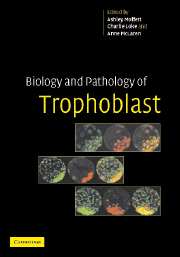Book contents
- Frontmatter
- Contents
- List of contributors
- List of participants
- Preface
- Chair's introduction
- 1 Trophoblast cell fate specification
- 2 Stem cells: pluripotency and extraembryonic differentiation in the mouse
- 3 Epigenetic regulation of trophoblast development
- 4 Regulation of X-chromosome inactivation in relation to lineage allocation in early mouse embryogenesis
- General discussion I
- 5 Gestational trophoblastic disease
- 6 Trophoblast and the first trimester environment
- 7 Implantation is a sticky situation
- 8 Trophoblast regulation of maternal endocrine function and behaviour
- General discussion II
- Final general discussion
- Index
- Plate section
- References
7 - Implantation is a sticky situation
from General discussion I
Published online by Cambridge University Press: 07 August 2009
- Frontmatter
- Contents
- List of contributors
- List of participants
- Preface
- Chair's introduction
- 1 Trophoblast cell fate specification
- 2 Stem cells: pluripotency and extraembryonic differentiation in the mouse
- 3 Epigenetic regulation of trophoblast development
- 4 Regulation of X-chromosome inactivation in relation to lineage allocation in early mouse embryogenesis
- General discussion I
- 5 Gestational trophoblastic disease
- 6 Trophoblast and the first trimester environment
- 7 Implantation is a sticky situation
- 8 Trophoblast regulation of maternal endocrine function and behaviour
- General discussion II
- Final general discussion
- Index
- Plate section
- References
Summary
Abstract. For many reasons the implantation process has been extraordinarily difficult to study. The molecules that orchestrate this highly specialised event are likely localised to the interacting surfaces of only a few embryonic and maternal cells. Additionally, their expression, which is precisely timed, may also be transient. Therefore, much of what we know about this process at a molecular level, such as the importance of leukaemia inhibitory factor (LIF), is a by-product of studying mutant mice that were generated for other purposes. In other cases, the ‘candidate molecule’ approach has been fruitful, as exemplified by recently published evidence that L-selectin and its carbohydrate ligands are involved in the initial stages of implantation. In this review we discuss the current body of knowledge regarding L-selectin functions, which prompted experiments to examine expression of this receptor and its specialised carbohydrate ligands during implantation and the early stages of placentation. The results highlight the amazing plasticity of trophoblast cells that have co-opted portions of vascular and leukocyte differentiation programmes. The challenge now is to use our knowledge of the trophoblast L-selectin adhesion system to benefit women who fail to conceive due to defects in the implantation process.
Introduction
After fertilization, the next major hurdle for human reproduction is trophoblast differentiation, which is required for implantation, followed in lockstep by rapid assembly of these embryonic cells into a functional placenta.
- Type
- Chapter
- Information
- Biology and Pathology of Trophoblast , pp. 132 - 147Publisher: Cambridge University PressPrint publication year: 2006



